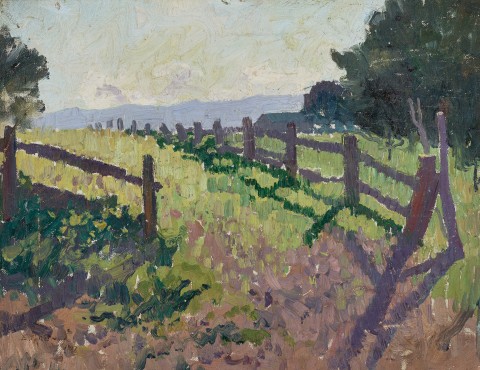FIELD, 1917
ELIOTH GRUNER
oil on canvas on compressed card
28.5 x 37.0 cm
signed and dated lower left: E GRUNER / 1917
Private collection
Sotheby’s, Melbourne, 22 April 1991, lot 247 (as 'Fields')
Joseph Brown Gallery, Melbourne, acquired from the above
The Cbus Collection of Australian Art, Melbourne, acquired from the above on 8 May 1991
Overland, Latrobe Regional Gallery, Victoria, 10 March – 15 July 2012
Colour and Movement, Benalla Art Gallery, Victoria, 19 February – 9 June 2016
Figures and Landscapes, Latrobe Regional Gallery, Victoria, 16 December 2017 – 11 March 2018
on long term loan to Gippsland Art Gallery, Victoria
Nainby, B., Stanhope, Z., and Furlonger, K., The Cbus Collection of Australian Art, in association with Latrobe Regional Gallery, Melbourne, 2009, pp. 16, 41 (illus.), 220
Spring Morning, 1917, oil on cardboard on canvas, 40.0 x 29.1 cm, in the collection of the Newcastle Regional Art Gallery, New South Wales
Field, 1917 was executed en plein air at a farm owned by James Innes at Emu Plains, near the Nepean River on the lands of the Darug people. Set on ‘rising land in the shadow of the Blue Mountains’,1 Gruner stayed on the property in a small hut, sleeping on its floor, ‘wrapped up in chaff bags to keep the chill out of his blood, (and watching) for those clear, colourless dawns to arrive, with a palette set to a key that would paint the unpaintable, light itself.’2 In a letter to Hans Heysen in 1918, Gruner exclaimed that ‘I simply must work on the spot or be absolutely in touch with it.’3
One measure of Gruner’s early success was his triumph in the Wynne Prize of 1916 with Morning light, 1915, his first of seven such awards. He had originally studied at Julian Ashton’s art school (later teaching there) and in 1915, explored Max Meldrum’s tonalist theories, the legacy of which may be seen in Morning light. In Field, however, Gruner breaks from the smooth ambiguity of Meldrum and applies his paint in distinct, impastoed strokes to capture the lushness of the grassy field, the fences that bisect it, and the deep viridian green of the shadows. The sense of immediacy is heightened by patches of bare canvas left exposed in these areas, with the whole surmounted by the blue of the distant mountains and a sky whose windy turbulence is evocatively implied by energetic strokes of swirling pigment.
1. Clark, D., Elioth Gruner: Texture of light, Canberra Museum and Gallery, Canberra, 2014, p.24
2. Lindsay, N., ‘Foreword’, Elioth Gruner: twenty-four reproductions in colour from original oil paintings, Shepherd Press, Sydney, 1947, n.p.
3. Elioth Gruner, letter to Hans Heysen, 1918, cited in Pearce, B., Elioth Gruner, 1882-1939, Art Gallery of New South Wales, Sydney, 1983, p.8
ANDREW GAYNOR
